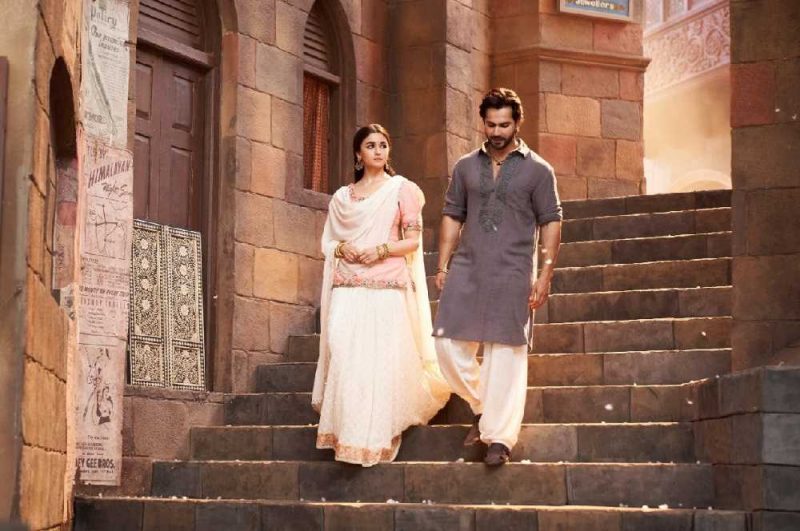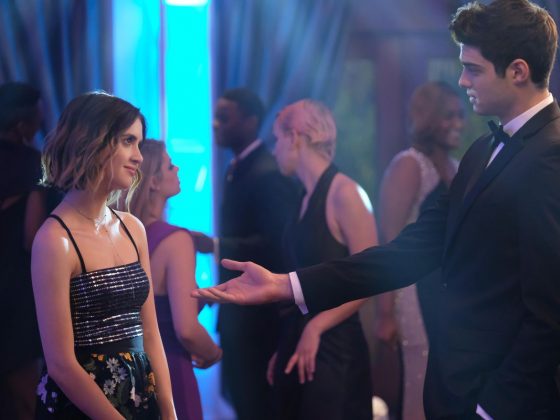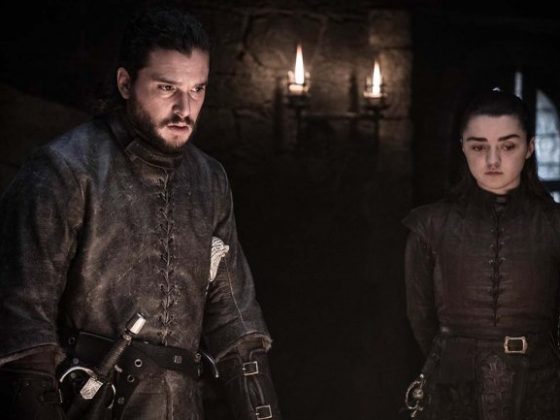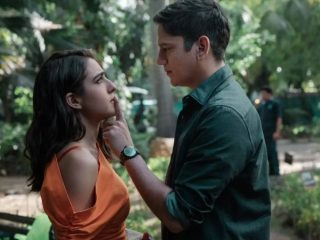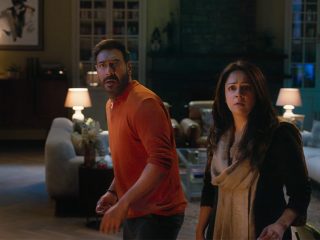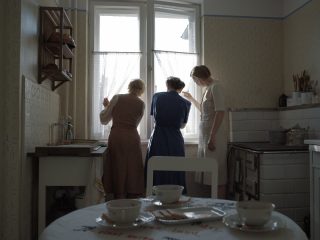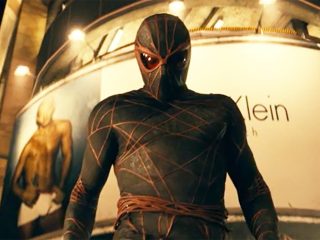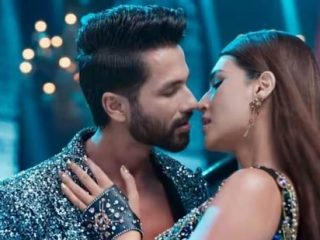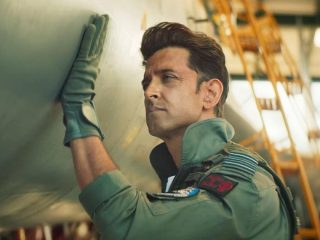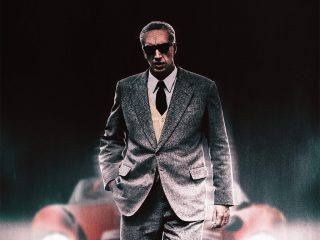There is pretty much nothing that can go wrong when you have a star cast comprising of Varun Dhawan, Alia Bhatt, Aditya Roy Kapur, Sonakshi Sinha, Sanjay Dutt and Madhuri Dixit, the ones who have ruled the box-office. Except when they are put together in a film that is 2 hours and 48 minutes long. Well first things first. The movie is spectacular and has gorgeous opulent sets. Not even a luminous Madhuri Dixit, and a stunning Alia Bhatt can salvage this poorly written film. The film’s canvas has captured the pre-independence era perfectly, but a weak plot ruins it. From the trailer it seemed the film would be more than the grandeur, but sadly it isn’t. We suggest you to keep your logic at home. There is a moment in the film when Aditya Roy Kapur’s character tells Alia to not have expectations from him. Well, you have to do the same as well.
Storyline: The movie is set in 1947, Roop (Alia), a ‘village girl’, wearing Rajasthani clothes and singing a Rajasthani song but dancing and frolicking against the backdrop of snow-clad mountains, is coerced into marrying a rich man Dev Chaudhary (Aditya Roy Kapur). The union is formed by Satya (Sonakshi Sinha), Dev’s wife who has Cancer and has only a year to live. She wants to see her husband taken care of after her death.
Roop is educated but born to a poor musician, but agrees to this loveless deal so as to lift her family from poverty and take care of her sisters. However, her father and her sisters are never mentioned again in the film. She moves to the Choudharys’ mansion in Husnabad — near Lahore’s red-light area, Hira Mandi.
Roop ignores her disinterested husband and his rich father, Balraj (Sanjay Dutt in granny glasses) — who is carrying a deep secret as well.
Roop does not want to be a part of Dev’s life — until Satya lets her learn music from Bahar Begum (Madhuri), Hira Mandi’s famous courtesan who runs an infamous Kotha. Here, Roop meets Zafar (Varun Dhawan), a kohl-eyed, swaggering sexy bastard (literally) who is a regular at Baahar Begum’s Kotha. Dhawan and Madhuri share cold vibes, but that is explained much later in the film. The excruciatingly long first half comes to an end and we understand how the characters are the way they are. Although the wait is a challenge. Most of the time, you’re wandering about in hollow sets, all glass walls and synthetic chandeliers, zari, brocade and maang-tikas that give the chandeliers a run. But as they say all that glitters is not gold and that goes for this film as well. The sets are stunning, especially Baahar Begum’s Kotha, which looks more like a palace than a brothel.
Performances: Varun Dhawan plays the rebellious, kohl-eyed casanova who is out to sweep any woman off her feet as he does to Alia Bhatt. He and Alia have the most screen time throughout the film. It is a pity because Aditya Roy Kapur with all his stoicness has more depth to his character. Same as Sonakshi Sinha who looks her gracious best as Satya, but does not have much of a screen time. Varun Dhawan reminds us of Shah Rukh Khan in yore days when he played the role of a menacing lover. In today’s millennial language, Varun Dhawan plays a f*ckboi. Alia Bhatt who has proved her salt as an actress does not impress much as Roop. Roop is a more refined version of Geet from Jab We Met.
You’re not helped by the mostly flat acting of all — except Madhuri Dixit, who, queen-like, lights up the screen. She simply raises an eyebrow, twirls a finger, twinkles her eyes — and the screen goes ablaze. I wanted whistle badly when she naughtily murmurs, filhaal is guftagu se thak gaye hain hum. Sanjay Dutt as the Chaudhary family patriarch does not have much of a role and can be seen in only a few scenes.
However, it is Madhuri Dixit who makes Kalank bearable. Bahaar Begum sets the screen ablaze simply by raising an eyebrow or twirling a little finger. The second half is better panned out than the first half. We get to see more of Aditya Roy Kapur and quite rightly so!
Dev’s character comes in the picture as quiet force. A scene where Dev and Zafar meet has more chemistry here than between the heroes and heroines. Thankfully, it’s Aditya’s face that impresses — he’s impassive but conveys stormy feeling within. Without mouthing lines like — ‘Woh ek aandhi ki tarah meri zindagi me aaya’. ‘Kuch rishte karz ki tarah hote hai jo chukane padte hai’. Kalank dialogues are full of slam poetry — that’s fine if you like masaledaar Bollywood. I only wish its actors had acted more, instead of bizarre distractions, including an equally bizarre CGI bull fight.
The second half also sheds lights on the personal turmoil faced by each character. Also, Kunal Kemmu surprises in a negative role who is a leader of a Muslim political party and is supporting the Partition. The finale’s train sequence will remind you of the DDLJ train sequence, but is heartbreaking and shattering.
Direction and Execution: Let us just add here that one must leave period dramas to Sanjay Leela Bhansali. Kalank was definitely not up Abhishek Varman’s alley. One keeps wondering as to how a fictional town of Husnabad is home to snow clad mountains, a Venetian lake, a spick and span red-light area, a brothel that resembles a palace and looks more grand than the Chaudhary family house. The sets look like sets, and that is a major problem with the film. The elaborate song sequence of ‘Ghar More Pardesiya’ looks like a stage performance than a movie song. As a twitter user rightly mentioned there has been no attention paid to Geography. Also, it made me squirm to see a bit of shameless product placement in the film which otherwise had a serious plot in the periphery. Karan Johar also managed to plug-in his next magnum opus, another period film – Takht. You will have to watch the film to know more about it. Binod Pradhan’s cinematography is top notch, there are no complains about the red hues you see throughout the film. But it was marred by a shoddily written script and a misplaced direction. Kalank plays on the clichés of the films in the 1950s- illegitimate child, courtesan-rich man affair, forbidden love, Hindu- Muslim love, partition, the Victorian concept of a dying woman marrying her husband to another woman. It had way too many plots going on at the same time. Not to forget the important storyline of the Partition and the Hindu-Muslim discord in Lahore. The song Tabaah Ho Gaye appears out of nowhere and the audiences are left wondering what made the courtesan dance, especially since it had been previously established that she had quit dancing to teach singing.
Music: The music by Pritam is indeed pleasant. While Tabaah Ho Gaye, Ghar More Pardesiya are the ones which are winning hearts, my favourite is Lai Ve Mohe Rajvaadi Odhani, which is also Alia Bhatt’s introductory song.
This movie marks a strong comeback of Madhuri Dixit. This is like her homecoming after her previous dominant portrayals of similar characters in Devdas and Gulaab Gang.. The costumes may be anachronistic but the characters carry a certain weight and Old Testament integrity with themselves The casting has been apt according to the strengths of all the concerned actors, but still Varun and Alia don’t have the same chemistry as they did in their previous pairings.
Sets are patchy but the investment of money on recreating the 1940s is visible (even if they don’t pull it off completely). One positive can also be hearing Shreya Ghoshal do a wonderful playback for Madhuri Dixit in Tabaah Ho Gaye, after Dola Re Dola in Devdas. That’s a wonderful throwback even though the song is not up to the mark.
Also the producers did a casting coup of sorts by getting the famous ex couple of Sanjay and Madhuri together after ages. Period dramas could possibly get a boost as a genre and can be attempted by more filmmakers than just Sanjay Leela Bhansali after seeing the potential of Kalank (even though they would want to make a much better period drama than this). We give 2 chirps to this film.

